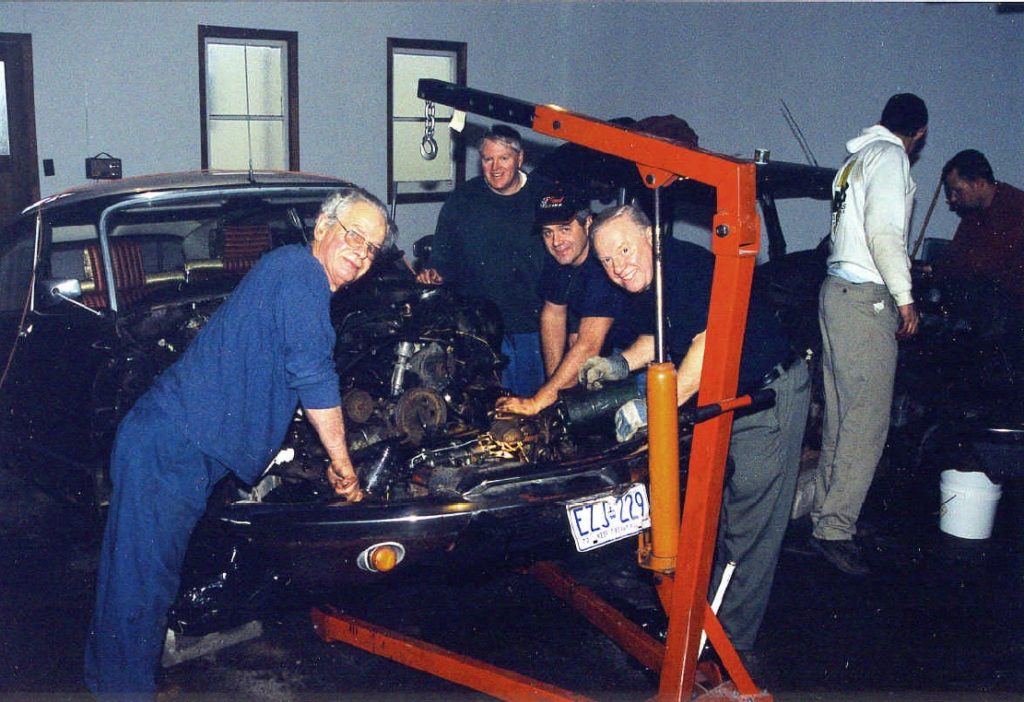DS Rescue Bid a Success
– by Lorne Vineberg
On January 12, 2002, a core of club members brought their toolboxes, skills, knowledge, experience and enthusiasm to Joe Whibbs’ property in the rolling outskirts of Peterborough. To the uninitiated, it is as shocking as an ICU to enter a garage and behold a skeletal Citroën donor car. The gut response is, “Can’t it be saved?”. This one was beyond salvation. But it offered new hope to the 1972 DS with hardened arteries beside it in the bright double garage warmed with space heaters. Joe is a very kind soul to let his son Mike rest two D’s in there for use as an operating room. A fresh pot of coffee and our national dish, Tim Horton’s muffins and donuts, greeted Team Citroën on the workbench.
 The “D” Team
The “D” Team
There seems lots to disconnect before a D gives up its engine and transmission. Mallet, hacksaw, crowbar and physical contortions helped in the few stubborn instances where WD-40 didn’t. At one point, as someone sprayed WD-40 on a dirty cable lock-down point in anticipation of freeing it, Bob DeBruyn looked up over the rim of his glasses and casually said, “You don’t need that — its stainless steel,” flipping it out with a screwdriver almost without looking as he spoke. Ah, experience! After a few false starts where one hose or tube after another seemed to remain connected or snagged, the ‘good’ D surrendered its diseased heart in preparation for the transplant.
 Engine transplant procedure “donor”.
Engine transplant procedure “donor”.
An admirable grease-scrubbing job readied the engine compartment with a cleaner frame and gleaming aluminum aerodynamic underpanels. With the seized engine finally hoisted and set temporarily on the garage floor, work came to halt and we broke for a country lunch spread inside. George Dyke cheerfully remarked that it had taken eight or so of us only a bit over three hours to reach that point. Optimistic projections were that we would be easing the working motor into the Whibbs’ lovely maroon and gray D within an hour after lunch.
Predictions are made to be broken, and this estimate proved inaccurate by about 12 hours, but for good reason. Part of that time was needed to lift engine and hoist out of the mud, where they had sunk, after they had been moved outside to for a pressure-spray de-greasing. It was decided that with both engines out, this was definitely the time to separate the transmissions of each, do a clutch replacement and determine the better transmission. Methodical planning also dictated inspecting the timing chain. With these mechanical details to execute we also decided to do a full strip of the donor car carcass. This activity wrapped up about midnight!
 Out with the old block…
Out with the old block…
The fellowship of people working voluntarily to assist each other is all too rare, and it made the grime and minor injuries a small price to pay. Not only were we sharing a challenge, we were saving a soul, spiritually speaking. Every preserved example of Citroën’s golden age counts. We will not see their likes pass this way again — like André, himself. And the experience was educational. I hadn’t realized that the D could be considered a mid-engine car because its engine and transmission sit behind rather than above the front wheels. That accounts, in part, for its stability on ice. As a novice I was astonished to discover that the green lifeblood of the sophisticated hydraulic system flows from a prosaic looking cylindrical mini oil drum (a humdrum, perhaps) rather than some lyrical reservoir case in a French motif.
Interestingly, the Whibbs and club members came across each other quite by chance last summer on a sunny club drive to Doug’s cottage. The knowledge transfer, preservation of a Citroën and camaraderie of this rescue show the tremendous benefits of operating like a club. Vive la participation!
